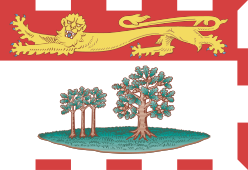
The Union Jack, or Union Flag, is the de facto national flag of the United Kingdom. The Union Flag was also used as the official flag of several British colonies and dominions before they adopted their own national flags. The flag continues to have official status in Canada, by parliamentary resolution, where it is known as the Royal Union Flag.

The National Flag of Canada, often simply referred to as the Canadian flag or, unofficially, as the maple leaf flag or l'Unifolié, consists of a red field with a white square at its centre in the ratio of 1∶2∶1, in which is featured a stylized, red, 11-pointed maple leaf charged in the centre. It is the first flag to have been adopted by both houses of Parliament and officially proclaimed by the Canadian monarch as the country's official national flag. The flag has become the predominant and most recognizable national symbol of Canada.

The flag of Quebec, called the Fleurdelisé, represents the Canadian province of Quebec. It consists of a white cross on a blue background, with four white fleurs-de-lis.

The coat of arms of Prince Edward Island, officially the King's Arms in Right of Prince Edward Island, are the coat of arms of Prince Edward Island, being the arms of King Charles III in right of the province. They were created when the shield and motto in the achievement were granted in 1905 by royal warrant from King Edward VII. The latest iteration was given by the Canadian Heraldic Authority in 2002.

The coat of arms of Saskatchewan, officially known as His Majesty's Arms in right of Saskatchewan, is the heraldic symbol representing the Canadian province of Saskatchewan.
The Canadian order of precedence is a nominal and symbolic hierarchy of important positions within the governing institutions of Canada. It has no legal standing, but is used to dictate ceremonial protocol.
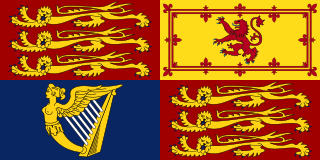
The Royal Standards of the United Kingdom presently refer to either of two similar flags used by King Charles III in his capacity as Sovereign of the United Kingdom, the Crown dependencies, and the British Overseas Territories. Two versions of the flag exist, one for use within Scotland and the other for use elsewhere.

The flag of New Brunswick consists of a golden lion passant on a red field in the upper third and a gold field defaced with a lymphad on top of blue and white wavy lines in the bottom two-thirds. Adopted in 1965 shortly after the new national flag was inaugurated, it has been the flag of the Canadian province since February 24 of that year. It is a banner of arms modelled after the province's coat of arms.

The coat of arms of Ontario is the armorial emblem representing the Canadian province of Ontario. The arms contain symbols reflecting Ontario's British heritage, along with local symbols. At the upper part of the shield is the red cross of St. George, representing England. The lower portion of the shield features three golden maple leaves on a green background.

The flag of Manitoba consists of a Red Ensign defaced with the shield of the provincial coat of arms. Adopted in 1965 shortly after the new national flag was inaugurated, it has been the flag of the province since May 12 of the following year. Its adoption was intended to maintain the legacy of the Canadian Red Ensign as the country's unofficial flag, after the adoption of the Maple Leaf Flag in 1965. Manitoba's flag has been frequently mistaken for the flag of the neighbouring province of Ontario, which is also a Red Ensign with its respective coat of arms. This, along with criticisms of a lack of inclusivity of the flag, has led some Manitobans to call for a new and more distinct flag.

The flag of Nova Scotia consists of a blue saltire on a white field defaced with the royal arms of Scotland. Adopted in 1929 after a royal warrant was issued, it has been the flag of the province since January 19 of that year. It is a banner of arms modelled after the province's coat of arms. Utilized as a pennant since 1858, it was officially recognized under primary legislation as Nova Scotia's flag in 2013. When flown with the flags of other Canadian provinces and the national flag, it is fourth in the order of precedence.
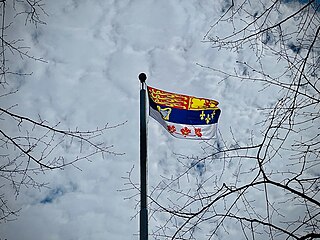
The royal standards of Canada are a set of personal flags used by members of the Canadian royal family to denote the presence of the bearer within any vehicle, building, or area within Canada or when representing Canada abroad. All are based on a banner of the coat of arms of Canada, which are the arms of the Canadian monarch.

Regional tartans of Canada are represented by all Canada's provinces and territories having a regional tartan, as do many other regional divisions in Canada. Tartans were first brought to Canada by Scottish settlers; the first province to adopt one officially was Nova Scotia in 1956, and the most recent province was Ontario, in 2000. Except for the tartan of Quebec, all of the provincial and territorial tartans are officially recognized and registered in the books of the Court of the Lord Lyon, King of Arms of Scotland.
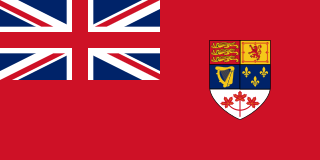
The Canadian Red Ensign served as a nautical flag and civil ensign for Canada from 1892 to 1965, and later as the de facto flag of Canada before 1965. The flag is a British Red Ensign, with the Royal Union Flag in the canton, adorned with the shield of the coat of arms of Canada.

The lieutenant governor of Prince Edward Island is the representative in Prince Edward Island of the Canadian monarch, King Charles III, who operates distinctly within the province but is also shared equally with the ten other jurisdictions of Canada, as well as the other Commonwealth realms and any subdivisions thereof, and resides predominantly in his oldest realm, the United Kingdom. The lieutenant governor of Prince Edward Island is appointed in the same manner as the other provincial viceroys in Canada and is similarly tasked with carrying out most of the monarch's constitutional and ceremonial duties.

The flag of the governor general of Canada is a flag used as a symbol to mark the presence of the governor general of Canada. Such a flag has been used by governors general since just after Canadian Confederation and the design has altered over decades. The current flag was adopted in 1981.
As the viceregal representative of the monarch of Canada, the lieutenant governors of the Canadian provinces have since Confederation been entitled to and have used a personal standard. Within a lieutenant governor's province, this standard has precedence over any other flag, including the national one, though it comes secondary to the Sovereign's Flag for Canada. The provincial viceregal flags are also subordinate to the governor general's personal standard, save for when the governor general is present as a guest of the lieutenant governor.
The Prince Edward Island order of precedence is a nominal and symbolic hierarchy of important positions within the province of Prince Edward Island. It has no legal standing but is used to dictate ceremonial protocol at events of a provincial nature.
- The King of Canada
- The Lieutenant Governor of Prince Edward Island, or, in her official absence, the Administrator
- The Premier of Prince Edward Island
- The mayor or other elected senior official of an incorporated municipality when the ceremony or event is hosted by or particularly involves that municipality
- The Chief Justice of Prince Edward Island
- The Speaker of the Legislative Assembly of Prince Edward Island
- Former lieutenant governors, with relative precedence governed by their date of leaving office
- Former premiers, with relative precedence governed by their date of leaving office
- Members of the Executive Council of Prince Edward Island
- The Chief Justice of the Supreme Court of Prince Edward Island
- Justices of the Supreme Court of Prince Edward Island, with relative precedence governed by date of appointment
- The Chief Judge of the Provincial Court of Prince Edward Island
- Judges of the Provincial Court of Prince Edward Island, with relative precedence governed by date of appointment
- Members of the Legislative Assembly of Prince Edward Island
- Members of the Senate of Canada
- Members of the House of Commons of Canada
- Mayors or other elected senior officials of incorporated municipalities outside their municipality, alphabetically by municipality name
- The Bishop of Charlottetown, the Bishop of Nova Scotia and the President of the Queens County Ministerial Association, with relative precedence governed by date of appointment or election
- The Senior Officer for the Royal Canadian Mounted Police in Prince Edward Island
- The President of the University of Prince Edward Island
- Deputy heads of departments, agencies, commissions and offices of the Provincial Government, with relative precedence governed by date of initial appointment as a Deputy Head

Canadian heraldry is the cultural tradition and style of coats of arms and other heraldic achievements in both modern and historic Canada. It includes national, provincial, and civic arms, noble and personal arms, ecclesiastical heraldry, heraldic displays as corporate logos, and Canadian blazonry.
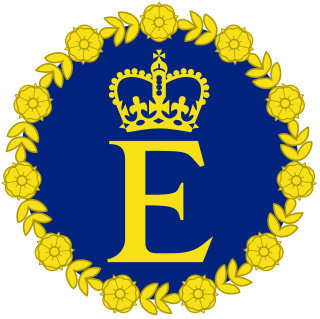
Queen Elizabeth II had a variety of flags to represent her personally and as head of state of several independent nations around the world. They were usually used on any building, ship, car, or aircraft where she was present.
